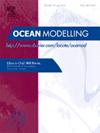评估模拟东南极洲Prydz湾陆冰的单柱热力学海冰模式
IF 2.9
3区 地球科学
Q2 METEOROLOGY & ATMOSPHERIC SCIENCES
引用次数: 0
摘要
为了评估不同物理过程对海冰热力学模拟不确定性的贡献,采用高分辨率雪/冰模式(HIGHTSI)、节能模式(BL99)、糊状层模式(mushy)和0层模式(0LAYER) 4种单柱模式对陆地海冰的生长和融化进行模拟。这些模拟是根据中山站的观测数据进行的,并与2015年7月至12月在南极洲Prydz湾收集的原位测量数据进行了验证。结果表明,由于忽略了风对积雪再分布的影响,所有模式在模拟雪深方面都存在显著偏差,导致冰厚模拟误差超过5%。短波辐射吸收参数化和升华过程至关重要地决定了融雪的开始时间。在所有模式中,HIGHTSI对观测结果的冰厚偏差最小(0.04 m),这主要归因于雪热导率的差异。这一单一因素导致BL99、MUSHY和0LAYER模拟的冰比HIGHTSI薄7.3%。结合生长焓和盐度耦合的模型(如BL99)对初始盐度剖面具有很高的敏感性。本研究通过数值模拟与现场观测的比较,量化了海冰热力学中各种物理过程的相对重要性。研究结果阐明了不同模型的可行性,为今后的模型优化提供了坚实的参考依据。本文章由计算机程序翻译,如有差异,请以英文原文为准。
Evaluating single-column thermodynamic sea ice models for simulating landfast ice in Prydz Bay, East Antarctica
To evaluate the contributions of different physical processes to sea ice thermodynamic simulation uncertainties, four single-column models were employed to simulate the growth and melting of landfast sea ice: high-resolution snow/ice model (HIGHTSI), energy-conserving model (BL99), mushy layer model (MUSHY), and 0-layer model (0LAYER). These simulations were forced by the observations obtained at Zhongshan Station and validated against in situ measurements collected between July and December 2015 in Prydz Bay, Antarctica. The results indicate that all the models exhibit significant biases in terms of the simulated snow depth because snow redistribution by wind is neglected, leading to errors in ice thickness simulations of more than 5 %. Shortwave radiation absorption parameterizations and sublimation processes crucially determine the onset timing of snowmelt. Among all the models, HIGHTSI results in the smallest ice thickness bias from the observations (0.04 m), which is attributed primarily to differences in snow thermal conductivity. This single factor causes BL99, MUSHY, and 0LAYER to simulate 7.3 % thinner ice than does HIGHTSI. Models incorporating coupled growth enthalpy and salinity (e.g., BL99) showed high sensitivity to initial salinity profiles. This study quantifies the relative importance of various physical processes in sea ice thermodynamics through comparing numerical simulations with in situ observations. The results clarify the feasibility of different models and provide solid references for model optimization in the future.
求助全文
通过发布文献求助,成功后即可免费获取论文全文。
去求助
来源期刊

Ocean Modelling
地学-海洋学
CiteScore
5.50
自引率
9.40%
发文量
86
审稿时长
19.6 weeks
期刊介绍:
The main objective of Ocean Modelling is to provide rapid communication between those interested in ocean modelling, whether through direct observation, or through analytical, numerical or laboratory models, and including interactions between physical and biogeochemical or biological phenomena. Because of the intimate links between ocean and atmosphere, involvement of scientists interested in influences of either medium on the other is welcome. The journal has a wide scope and includes ocean-atmosphere interaction in various forms as well as pure ocean results. In addition to primary peer-reviewed papers, the journal provides review papers, preliminary communications, and discussions.
 求助内容:
求助内容: 应助结果提醒方式:
应助结果提醒方式:


